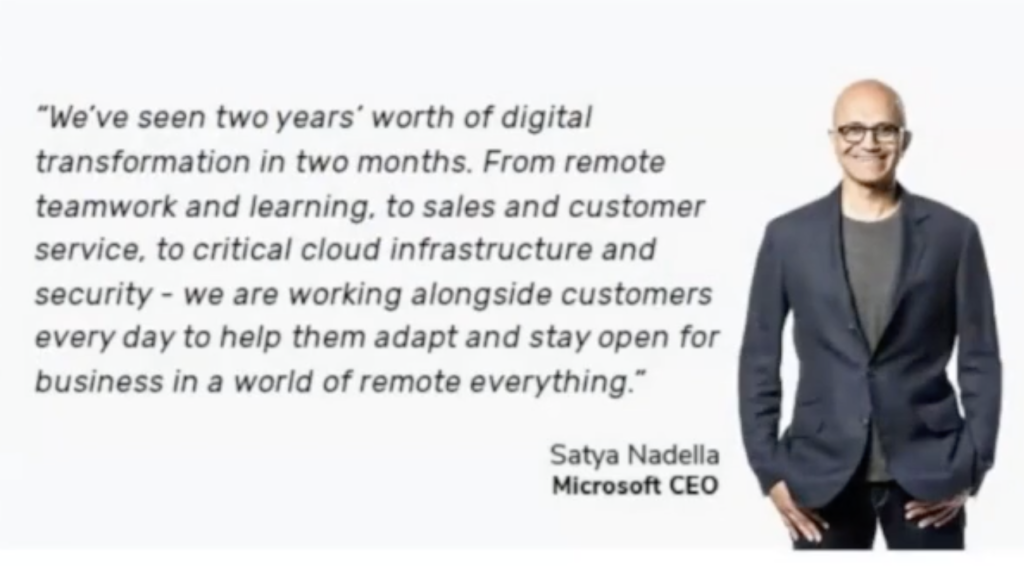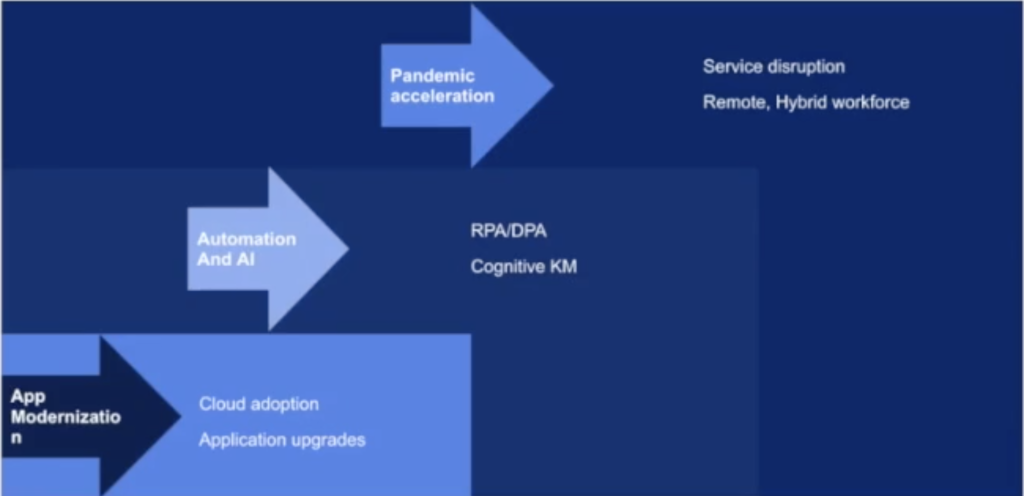According to Forrester, 40% of global infrastructure decision-makers say that improving their use of data insights in business decision-making will be a high or critical business priority for their organization in the coming year.
In her recently published report, Digital Adoption Platforms Are Essential Tech In The New Normal, lead author and senior analyst Vasu Srinivasan mention how DAPs promote self-service, boost adoption, and provide insights on experience, usability, and optimization opportunities for both internal users and end customers.
As Satya Nadella says “We have seen two years’ worth of Digital Transformation in two months. From remote teamwork to learning, to sales and customer service, to critical cloud infrastructure and security – we are working alongside customers every day to help them adapt and stay open for business in a world of remote everything”

This also leads to the question, of whether it has digital transformation has anything to do with the pandemic? Or were there already existing impacts, things in motion that may be contributing to the digital acceleration and the pandemic has just fast-forwarded it.
Starting with the enterprise focus on App modernization or improving their application environments, there may be three key forces that are complete accelerants to digital transformation. As a result, with businesses seeking greater flexibility and scalability in their corporate assets, the cloud has emerged as a vital component of the answer. Moving to the cloud also entailed big application improvements, which were planned, unplanned, or forced to some level, they had to let go of traditional application infrastructures, and they had to invest in things that were more scalable, adaptable, and available on the cloud. So there’s been a tremendous appetite or ground churn.

Secondly, Automation and AI have also had a significant impact on digital transformation. There is barely any service group or labor type that is unaffected by automation and AI. RPA(Robotic process automation) and digital process automation have grown so ubiquitous that people have begun to invest in and expand their own systems and one unintended effect of robotic process automation and technologies like RPA, ADP, or even Customer Service Automation, such as chatbots and virtual assistants, is that they have developed something of a minimum expectation to achieve.
Thirdly, the most prominent impact that the pandemic has delivered across all kinds of enterprises is the massive amount of service disruption and with that service disruption also came a massive amount of workforce disruption. Working from home, remote, or hybrid is now required from an operational standpoint and this is a problem that every company has to deal with because every company has at least a portion of its workforce that is either totally remote or, in some cases, hybrid. So organizations are making progress toward returning to work, but no one has fixed the problem yet. Enterprises are still hedging their bets on the size of the problem and the overall impact of the scenario for some of these accelerants.
40% of worldwide service decision-makers have changed their contracts to allow service providers to start working from home or in a remote work environment. This is a survey that was conducted immediately before the epidemic, so even after the pandemic, the number was significantly higher, and right now, as we consider returning to work and creating some sort of hybrid workforce, this figure is still very significant.
When it comes to managing a highly remote and scattered workforce, many businesses face a big difficulty on a regular basis. Another significant indicator that organizations wanted to learn more about is the obstacles when it came to digital transformation, notably those that stemmed from the faster efforts. Again, 40% of global infrastructure decision-makers indicate that having access to data and insights that can influence and offer better business decision-making is a crucial, or very high priority, for their organizations in the next 12 months. So it’s not only a question of whether the workforce has been distributed, it’s also a question of how they’ve been distributed.
Digital transformation has become a bit of a tightrope act for most enterprises. It’s a bit of a catch-22 everywhere because there are multiple conflicting priorities and multiple conflicts and complexities that exist within an organization, which makes it difficult to accelerate digital transformation.
When businesses quickly adopt new applications what essentially happens is massive friction between onboarding employees, moving them from older platforms to newer platforms, managing change, managing communications, and managing experience for all internal customers. There are obstacles in delivering learning and coaching to a highly spread workforce. How do you inculcate that culture of accepting newer technology, especially with people who have joined organizations during the pandemic period and haven’t had the opportunity to travel to physical office space and get acquainted with systems and technologies? This isn’t a one-time activity for any business out there. It’s not just information, it’s knowledge delivery, which has become a continuous exercise because employees constantly deal with dynamic applications that have constant upgrades and release notes. There’s also this tremendous knowledge activity that needs to remain continuing at a steady rate for it to be successful.
Vasupradha is a seasoned Customer Experience Management professional with over fifteen years of experience helping the Fortune 100 and other enterprises transition Support, Services, and Experience to digital channels. Vasupradha is currently associated with Forrester as a senior analyst.
Copyright © 2025 Whatfix. All rights reserved
This website is owned and operated by Whatfix Private Limited (Formerly known as Quicko Technosoft Labs Private Limited)